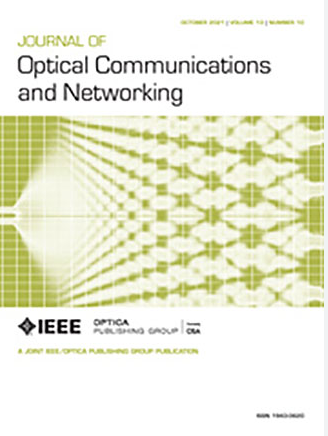基于直接调制激光器的端到端光通信系统优化
IF 4
2区 计算机科学
Q1 COMPUTER SCIENCE, HARDWARE & ARCHITECTURE
引用次数: 0
摘要
在低功耗、成本有限的短距离光链路中,使用直接调制激光器(DML)很有吸引力。然而,其有限的调制带宽会导致波形失真,影响数据吞吐量。传统的失真缓解技术主要依赖于发射端预失真和接收端均衡的单独训练。这种方法忽视了同时优化发送器(星座和脉冲整形)和接收器(均衡和符号解映射)所带来的潜在收益。此外,在 DML 运行中,激光驱动配置参数(如偏置电流和峰峰调制电流)的选择对系统性能有重大影响。我们为 DML 系统提出了一种新颖的端到端优化方法,将偏置和峰峰调制电流的学习与星座点、脉冲整形和均衡的优化结合起来。DML 动态仿真基于符号速率在 15 和 25 Gbaud 之间的激光速率方程。速率方程产生的输出序列用于建立可微分的数据驱动模型,从而简化端到端优化所需的梯度计算。建议的端到端方法与另外 3 种基准方法进行了比较:无均衡的无补偿系统、接收端有限脉冲响应均衡方法以及具有可学习脉冲形状和非线性 Volterra 均衡但具有固定偏置和峰峰调制电流的端到端方法。对这四种方法的数值模拟表明,在测试的符号率范围内,联合优化偏置、峰-峰电流、星座点、脉冲整形和均衡的方法优于所有其他方法。本文章由计算机程序翻译,如有差异,请以英文原文为准。
End-to-end optimization of optical communication systems based on directly modulated lasers
The use of directly modulated lasers (DMLs) is attractive in low-power, cost-constrained short-reach optical links. However, their limited modulation bandwidth can induce waveform distortion, undermining their data throughput. Traditional distortion mitigation techniques have relied mainly on the separate training of transmitter-side pre-distortion and receiver-side equalization. This approach overlooks the potential gains obtained by simultaneous optimization of the transmitter (constellation and pulse shaping) and receiver (equalization and symbol demapping). Moreover, in the context of DML operation, the choice of laser-driving configuration parameters such as the bias current and peak-to-peak modulation current has a significant impact on system performance. We propose, to our knowledge, a novel end-to-end optimization approach for DML systems, incorporating the learning of bias and peak-to-peak modulation current to the optimization of constellation points, pulse shaping, and equalization. The simulation of the DML dynamics is based on the use of the laser rate equations at symbol rates between 15 and 25 Gbaud. The resulting output sequences from the rate equations are used to build a differentiable data-driven model, simplifying the calculation of gradients needed for end-to-end optimization. The proposed end-to-end approach is compared to three additional benchmark approaches: the uncompensated system without equalization, a receiver-side finite impulse response equalization approach, and an end-to-end approach with learnable pulse shape and nonlinear Volterra equalization but fixed bias and peak-to-peak modulation current. The numerical simulations on the four approaches show that the joint optimization of bias, peak-to-peak current, constellation points, pulse shaping, and equalization outperforms all other approaches throughout the tested symbol rates.
求助全文
通过发布文献求助,成功后即可免费获取论文全文。
去求助
来源期刊
CiteScore
9.40
自引率
16.00%
发文量
104
审稿时长
4 months
期刊介绍:
The scope of the Journal includes advances in the state-of-the-art of optical networking science, technology, and engineering. Both theoretical contributions (including new techniques, concepts, analyses, and economic studies) and practical contributions (including optical networking experiments, prototypes, and new applications) are encouraged. Subareas of interest include the architecture and design of optical networks, optical network survivability and security, software-defined optical networking, elastic optical networks, data and control plane advances, network management related innovation, and optical access networks. Enabling technologies and their applications are suitable topics only if the results are shown to directly impact optical networking beyond simple point-to-point networks.

 求助内容:
求助内容: 应助结果提醒方式:
应助结果提醒方式:


